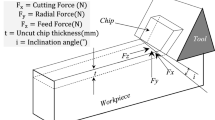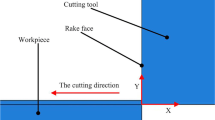Abstract
Literature survey showed that the micro-textures on the tool rake face can help in reduction in friction at chip-tool interface and therefore, reduction in the cutting forces. Consequently, the current work is based on FE simulation of hard turning of bearing steel (AISI52100). Four types of micro-textures have been considered on the tool rake face: non-texture, perpendicular, parallel, and rectangle. Johnson-Cook (J-C) material constitutive law has been considered for the workpiece with temperature-dependent material properties. Experimental work has been performed at cutting conditions: type, parallel; edge distance, 0.195 mm; pitch size, 0.110 mm; and height of the texture, 0.049 mm to validate the current machining model. Parametric study of effect of tool feature parameters on the cutting forces has been performed. Based on the current model, it is observed that the perpendicular shape showed the minimum cutting force. The maximum reduction of 28 % was predicted in the effective coefficient of friction compared to the non-textured surface. Additionally, effect of size of the texture (edge distance, pitch size, texture height) and the friction factor at tool-chip interface on the process responses is predicted. The perpendicular texture at an edge distance of 100 μm, pitch size of 100 μm, and texture height of 50 μm showed the most effective shape and size for the minimum cutting forces and effective friction. It is simulated that the chip flow angle can be governed by the shape/size of the texture on the tool rake face. It is expected that the current model can further be helpful in the characterization of other hard materials and complex texture shape/size.
Similar content being viewed by others
References
Huang Y, Chou YK, Liang S (2007) CBN tool wear in hard turning: a survey on research progresses. Int J Adv Manuf Technol 35(5–6):443–453. doi:10.1007/s00170-006-0737-6
Konig W, Berktold A, Koch KF (1984) Machining of hard materials, vol 2. CIRP, Annals of
Zhang J (2005) Process Optimization for Machining of hardend Steels. Ph. D. Thesis, Georgia Institute of Technology
Dawson TG (2002) Machining hardened steel with polycrystalline cubic boron nitride cutting tools. Ph.D. Thesis, Georgia Institute of Technology,
Al-Zkeri IA (2007) Finite element modeling of hard turning. Ph. D. Thesis, Ohio State University
Ramesh A, Melkote SN, Allard LF, Riester L, Watkins TR (2005) Analysis of white layers formed in hard turning of AISI 52100 steel. Mater Sci Eng A 390(1–2):88–97. doi:10.1016/j.msea.2004.08.052
Bruzzone AAG, Costa HL, Lonardo PM, Lucca DA (2008) Advances in engineered surfaces for functional performance. CIRP Ann Manuf Technol 57(2):750–769. doi:10.1016/j.cirp.2008.09.003
Evans CJ, Bryan JB (1999) “Structured”, “Textured” or “Engineered” surfaces. CIRP Ann Manuf Technol 48(2):541–556. doi:10.1016/s0007-8506(07)63233-8
Kawasegi N, Sugimori H, Morimoto H, Morita N, Hori I (2009) Development of cutting tools with microscale and nanoscale textures to improve frictional behavior. Precis Eng 33(3):248–254. doi:10.1016/j.precisioneng.2008.07.005
Lian Y, Deng J, Yan G, Cheng H, Zhao J (2013) Preparation of tungsten disulfide (WS2) soft-coated nano-textured self-lubricating tool and its cutting performance. Int J Adv Manuf Technol 68(9–12):2033–2042. doi:10.1007/s00170-013-4827-y
Pettersson U, Jacobson S (2006) Tribological texturing of steel surfaces with a novel diamond embossing tool technique. Tribol Int 39(7):695–700. doi:10.1016/j.triboint.2005.06.004
Dubrujeaud B, Vardavoulias M, Jeandin M (1994) The role of porosity in the dry sliding wear of a sintered ferrous alloy. Wear 174(1–2):155–161. doi:10.1016/0043-1648(94)90097-3
Blatter A, Maillat M, Pimenov SM, Shafeev GA, Simakin AV, Loubnin EN (1999) Lubricated sliding performance of laser-patterned sapphire. Wear 232(2):226–230. doi:10.1016/S0043-1648(99)00150-7
Costa H, Hutchings I (2009) Effects of die surface patterning on lubrication in strip drawing. J Mater Process Technol 209(3):1175–1180
Erdemir A (2005) Review of engineered tribological interfaces for improved boundary lubrication. Tribol Int 38(3):249–256. doi:10.1016/j.triboint.2004.08.008
Xie J, Luo MJ, Wu KK, Yang LF, Li DH (2013) Experimental study on cutting temperature and cutting force in dry turning of titanium alloy using a non-coated micro-grooved tool. Int J Mach Tools Manuf 73:25–36. doi:10.1016/j.ijmachtools.2013.05.006
Tatsumi T, Takeda J, Imai K, Hashimoto H (1999) An engineered tool and some results of fly-cut experiments. Precision Engineering, Nanotechnology, Vol 1, Proceedings. Shaker Verlag Gmbh, Aachen
Hintze W. EA, and Wurfels K. (1998) Tool for material removal machining. US Patent
Jianxin D, Ze W, Yunsong L, Ting Q, Jie C (2012) Performance of carbide tools with textured rake-face filled with solid lubricants in dry cutting processes. Int J Refract Met Hard Mater 30(1):164–172. doi:10.1016/j.ijrmhm.2011.08.002
Johnson GR, Cook WH A constitutive model and data for metals subjected to large strains, high strain rates and high temperatures. In: Proceedings of the 7th International Symposium on Ballistics (1983) The Hague. International Ballistics Committee, Netherlands, pp 541–547
Tang L, Huang J, Xie L (2011) Finite element modeling and simulation in dry hard orthogonal cutting AISI D2 tool steel with CBN cutting tool. Int J Adv Manuf Technol 53(9–12):1167–1181. doi:10.1007/s00170-010-2901-2
Obikawa T, Kamio A, Takaoka H, Osada A (2011) Micro-texture at the coated tool face for high performance cutting. Int J Mach Tools Manuf 51(12):966–972. doi:10.1016/j.ijmachtools.2011.08.013
Huang Y, Liang S (2003) Cutting forces modeling considering the effect of tool thermal property—application to CBN hard turning. Int J Mach Tools Manuf 43(3):307–315
Guo Y, Liu C (2002) 3D FEA modeling of hard turning. J Manuf Sci Eng 124(2):189–199
Umbrello D, Hua J, Shivpuri R (2004) Hardness-based flow stress and fracture models for numerical simulation of hard machining AISI 52100 bearing steel. Mater Sci Eng A 374(1):90–100
Ng EG, Aspinwall DK, Brazil D, Monaghan J (1999) Modelling of temperature and forces when orthogonally machining hardened steel. Int J Mach Tools Manuf 39(6):885–903. doi:10.1016/s0890-6955(98)00077-7
Heath P (1987) Properties and uses of Amborite. Carbide Tool J 19(2):12–14
Author information
Authors and Affiliations
Corresponding author
Rights and permissions
About this article
Cite this article
Kim, D.M., Bajpai, V., Kim, B.H. et al. Finite element modeling of hard turning process via a micro-textured tool. Int J Adv Manuf Technol 78, 1393–1405 (2015). https://doi.org/10.1007/s00170-014-6747-x
Received:
Accepted:
Published:
Issue Date:
DOI: https://doi.org/10.1007/s00170-014-6747-x




